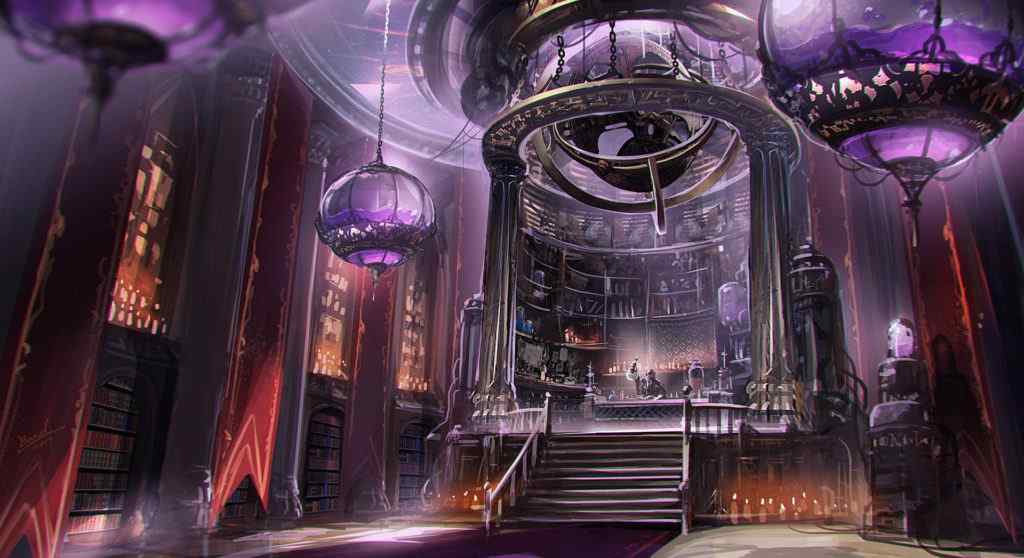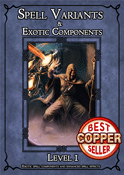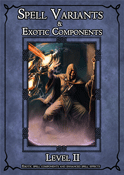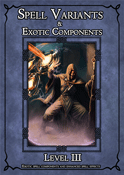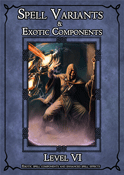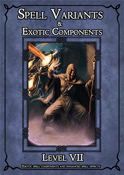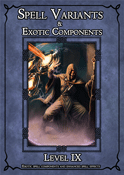Have a look at the SPELLS & VARIANTS section on this blog. You will the list of spells for D&D 5e, each one with the description of the standard spell plus at least one spell variant.
WHAT IS A SPELL?
A spell is a discrete magical Effect, a single shaping of the magical energies that suffuse the multiverse into a specific, limited expression. In Casting a Spell, a character carefully plucks at the Invisible strands of Raw Magic suffusing the world, pins them in place in a particular pattern, sets them vibrating in a specific way, and then releases them to unleash the desired effect—in most cases, all in the span of seconds.
Spells can be Versatile tools, Weapons, or protective wards. They can deal damage or undo it, impose or remove Conditions , drain life energy away, and restore life to the dead.
Uncounted thousands of Spells have been created over the course of the multiverse’s History, and many of them are long forgotten. Some might yet lie recorded in crumbling spellbooks hidden in ancient ruins or trapped in the minds of dead gods. Or they might someday be reinvented by a character who has amassed enough power and Wisdom to do so.
HOW TO HOMEBREW SPELLS IN D&D 5e
This article wants to provide you some basic tips to create/homebrew spells and spell effects by acting on what we call spell variables.
It doesn’t take too much, it is easy and it is fun.
OBSERVATION
As the spellcasters advance and reach higher levels, many low level spells become less useful.
I am not saying that they are useless, but higher challenges require higher power, and as a consequence many spells become vestigial and are used with less frequency.
FOREWORDS
When you have practiced the hobby of roleplaying for a long time, you inevitably homebrew stuff.
At the same time you learn how to properly balance your homebrew ideas with the simple technique of trial and correction.
It is perfectly normal to homebrew something – with the aid of your players – and then change your mind to adjust the outcome.
Of course, the same logic applies to D&D spells in 5e, spellcasting and spellcaster classes.
Magic is an essential part of roleplaying games, especially those based on fantasy setting. It is as important as the equipment list.
We know how magic and spellcasting works in D&D.
It is basically the same conceptsince the first version of OD&D.
Also, the variables that describe every spell have not changed too much from D&D 1e to D&D 5e.
SPELL VARIABLES ACROSS THE EDITIONS
AD&D 2ed: Range, Duration, Area of Effect, Components, Casting Time, Saving Throw.
D&D 3.0/3.5: Casting Time, Component, Area (or target), Duration, Saving Throw, Spell Resistance.
D&D 5ed: Casting Time, Range, Components, Duration.
As you can see, D&D 5ed simplified significantly the variables that define spell, leaving any missing element to be clarified in the spell’s description. In such case, the said “less is better” applies.
D&D 5ed also introduces a big change in how spell strength works. The strength of a spell is not related to the spellcaster’s level anymore.
The 5ed introduced the At Higher Levels concept, that allows you to spend a higher level spell slot, to produce more powerful spell effects, but not all spells have this option.
ACTING ON THE SPELL VARIABLES TO PRODUCE SPELL EFFECTS
The purpose of this article is to understand how to create spell variants by employing one or more of the variables above mentioned.
We are talking about the spell components, and to be more specific the material spell components.
Keeping in mind that we can also act on another variable as well, the casting time.
MORE OR LESS EXOTIC MATERIAL SPELL COMPONENTS
Across years or roleplaying I have noticed one fact about material spell components.
There are players (and Dungeon Masters also) that don’t care too much about material spell components, in the same way they don’t care too much about encumbrance in some way.
It’s fine, keeping track of everything is a pain in the ass, especially when the things I want to track produce minor effects in game terms.
At the same time, I have met players who seem to care about material spell components. It’s not that they want to precisely take note of each spell component on their character sheet. I mean, they are not fanatic of equipment, encumbrance and so on. No, not that.
Those players see material spell components as a way to introduce in the game interesting innovations to spellcasting and spell effects.
Let’s make some practical examples to better understand what we are talking about.
One of the spell that fascinates many players is Fireball. The spell employs verbal, somatic and material components. Specifically, the material components are sulphur and bat guano.
Why using these spell components?
Well, both sulphur and bat guano are flammables! It seems “logical” that both must have something to do with a spell like fireball.
What could happen if I decide to employ a more sophisticated material component, related to fire, other than sulphur or bat guano, to cast Fireball?
So, what are you (Dungeon Master) going to answer if a player ask you to use the fire of an Everlasting Torch to feed the Fireball spell? Or why not a Potion of Fire Breath? And what about the essence of a Fire Elemental?
As a Dungeon Master you have two possible answers.
NO. You just stick to the spell description and the discussion is over.
YES. You sit with the players to find a solution, and here is where homebrewing starts.
D&D 5e can be tweaked due to the simplicity of its game mechanics, that leaves the door open to many possibilities. At the same time, as the rule are simple, it also produce – and this inevitable – bugs and broken rules that have to be fixed. In any case, the last thing to do is touching the action economy, because that is when we make a real mess…no matter the edition.
In other words, you introduce a new material spell component based on the affinity the component has with:
- Nature of the spell
- Effect produced by the spell
If we agree that a material spell component helps the spellcaster in triggering and producing a sell effect, we can easily state that a better material spell component can provide a better spell effect.
Determining spell effects is about working on duration, area of effect, damage and damage type, saving throw, and so on after all.
Just have a look at literature and movies, where dark and creepy wizard’s labs have shelves filled with weird and exotic things coming from who knows where.
Some of these are very expensive, other are disgusting with a foul odor…and most of the time they are parts of creatures…which makes the whole matter even more creepy.
With this in mind we want to introduce new material spell components for each (or at least the majority of them) spell, in order to produce what we will call a spell variant or option.
SPELL VARIANTS
A spell variant is something that stands in the middle of a standard spell and a new spell.
So, it is not an entirely new spell.
It is something very close to the original spell, but it has been enhanced.
How? By changing the material spell components.
We can state now that, by using a different material spell component, we can enhance one of the spell variables to produce a different effect.
Example with Fireball. Imagine I have managed to capture the essence of a Fire Elemental. If I use – but not necessarily consume – the essence, I can master the energy of this being and enhance the damage of the fireball. Instead of inflicting Xd6 fire damage, I can inflict Xd8 fire damage, or – if the Dungen Master agree – I may decide to consume the material spell component and deal Xd8+1 fire damage.
It sounds fair after all.
I am not changing the core mechanics and I am not changing the action economy.
Just tweaking the rules about the spell components, so that by paying a higher price I produce something more powerful.
Example with Acid Splash. The spell inflicts 1d6 acid damage. The spell itself does not require any material spell component and is a level 0 spell. However, there are many stuff that are related to acid, and one classic example is the Gelatinous Cube. A good low level monster that you can encounter in any dungeon, a dangerous monster indeed, but not impossible to defeat. Why not allowing the spellcaster to extract and reserve a portion of the gelatinous cube and use it to enhance the Acid Splash that he loves so much using during the encounters? Now the wizard is able to cast Acid Splash and inflict 1d8 acid damage instead of 1d6.
CONSUMABLE (or not consumable) MATERIAL SPELL COMPONENTS
In the example of Fireball and Acid Splash, we said that the material component was not consumed in the spellcasting, while in the example of the Acid Splash spell, we said that the component was consumed.
I can assume that some spell components are consumed during the spellcasting, others are not.
As a general rule, the higher the spell level, the higher the chance that the spell consumes the component.
High level spells harness and unleash powerful energies, indeed their effect are more effective and destructive.
Using a piece of gelatinous cube to cast Acid Splash, is not the same as using the same spell component to cast Melf’s Acid Arrow for example.
At the same time we are assuming that the same material components can be used to cast different spells of different spell level.
Also, obtaining a piece of gelatinous cube is an easy task for a 4th level character, but not that easy for a 1st level character.
In other words, if a spell whose spell level corresponds to a certain character level and it matches with a monster’s challenge rating, I can state that the spell component should be consumed during the spellcasting, otherwise the components is not consumed.
Note that this is general statement, not a rule.
Mental flexibility is a must when homebrewing.
EXAMLE OF MATERIAL SPELL COMPONENTS
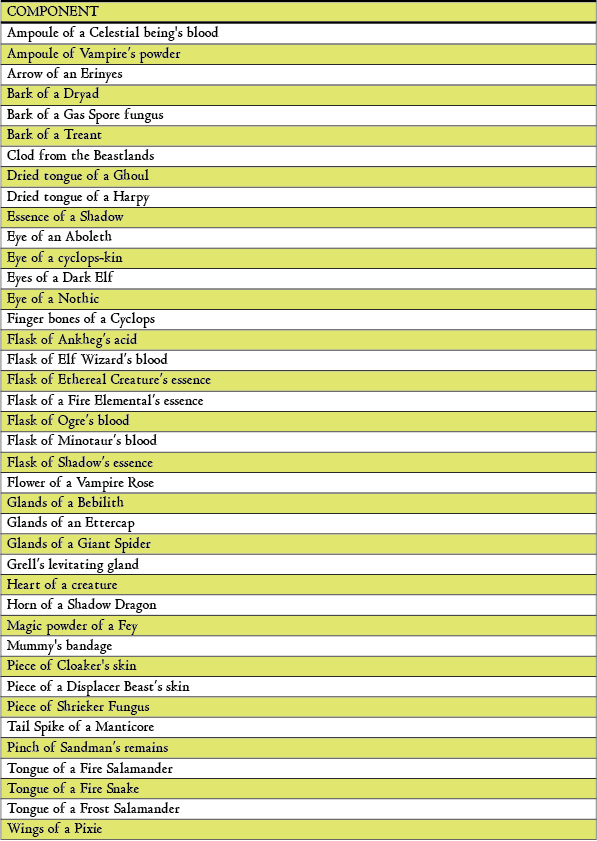
MATERIAL COMPONENTS CATEGORIES
If we have a look at movies, literature (and our game sessions too), we find plenty of examples of material spell components.
We can resume them into three categories:
EXOTIC MATERIALS
Into this category falls all those strange and weird stuff like monsters’ body parts, exotic colored fluids, etcetera. That is the classical lab of the mad wizard, who kidnap sods and then conduct creepy experiments to drain their life force and do amazing things. This is the most “imaginific” aspect of magic in fantasy setting, and as such, the one who allows players and Dungeon Master to create new things…especially villains.
SPELLS AS SPELL COMPONENTS
Spells can work as spell component to fuel more powerful and higher level spells. We have plenty of examples here. How many times have you seen the bad guy performing a ritual, while its minions are chanting weird songs to empower and support the ritual?
When we talk about spells as spell component we mean something like that. We are not stating that a spellcaster needs to surround himself of minions, we simply state that a spell can consume another spell and ehance its effects.
Example with Hold Person. The Hold Person spell can be consumed to empower a Hold Monster spell. Both spells have something in common, they paralyze a target. If I consume Hold Person to empower Hold Monster, I could increase the DC by one, or extend the duration, or produce a partial paralysis.
MAGICAL ITEMS AS MATERIAL COMPONENTS
Again, observe movies and literature. A magical item is an object imbued with permanent magic, that can produce magical effects on command.
Some of them possesses permanent magic powers, others have charges and limited use per day, many – like potions and scrolls – are one time use.
It is not wrong to state that a spellcaster can drain a bit of that power to feed a spell and make it stronger.
There are plenty of magical items that have very specific uses, and the character use it rarely and probably they end up selling the item because it is more useful having some coins in the purse.
Why not giving magical items a new purpose?
Many consumables items are sometimes stored, forgotten and later sold, because consuming them is not more convenient than taking a normal attack action.
Let’s assume that in the hand of a good spellcaster, these items may have a different and more interesting use.
Example with Staff of Fire. Staff are very powerful magicl items, especially those that produce effects from the evocation school. Beside the standard spells that a staff can reproduce and the charges they cost, I could easily manipulate the elemental forces to enhance any fire-based spells. I will not probably consume the staff in the process, but I can imagine that a 9th level spell can consume the staff when casting meteor swarm and increase the fire damage or the area of effect.
SPELL VARIABLES
Or better saying, what spell variables should we touch while creating a spell variant?
We already listed those variables. Being this article about D&D 5ed – without forgetting that the same principles can apply to any D&D system.
In D&D 5ed we can enhance the following variables:
- Area of effects
- Damage type
- Damage die
- Target
- Duration
Be careful when touching the variables presented in the spell entry, especially the casting time and the duration. Changing the casting time from 1 action to a bonus action increase the spell strength significantly, because we are touching the action economy. Avoid that.
In the same way, changing the duration by erasing the concentration requirement, greatly increases the spell strength.
So, when modifying the spell variables, think carefully about the materialcomponent cnsumed in the spellcasting and the spell level.
CONCLUSIONS
As usual, I suggest to invent, test and correct, and see what happens.
There are infinite possibilities to work with, things to put on the table, adventure hooks, adventure ideas.
Mistake to make, that can always be corrected.
Extraplanar gates that accidentally open…and horrible horrors that don’t know what a door is, and even less what knocking means.
I have made some pdf about this topic, just have a look at the library, all availables on DrivethruRpg.
LIBRARY
Products to support the blog
